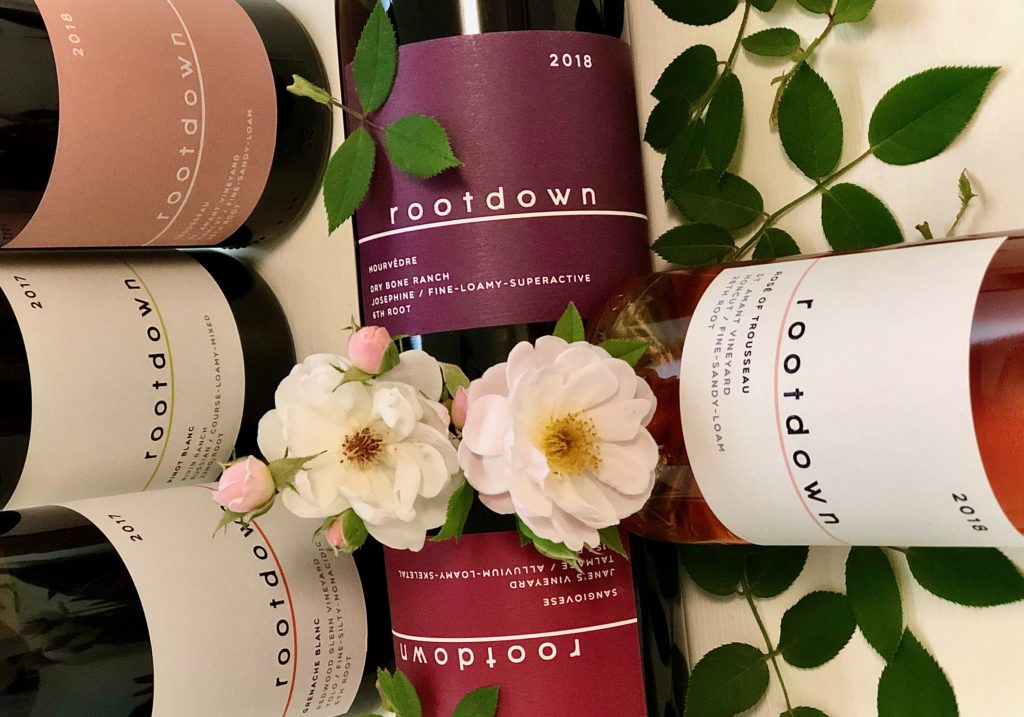Mike Lucia’s food-friendly wines upend conventional notions.
“Good thing I have a nondogmatic palate,” I wrote in my notebook’s margin during the first of two tastings (a week apart) of recent Rootdown Wine Cellars releases. Winemaker Mike Lucia upends conventional notions about what to emphasize in certain varietals. He’s also interested in lower-profile grapes like Trousseau, which he makes into rosé and a carbonic red.
Lucia’s single-vineyard wines, well-conceived and crafted with finesse, are from grapes grown in Sonoma, Mendocino, and the Gold Country’s Amador County, their vineyards chosen for soil type and location. As a group the low-alcohol, high-acid, food-friendly wines come across as clean and unmanipulated, with Lucia, whose previous experience includes time at DeLoach, Goldeneye, and Copain, approaching the varietals with respect even as he rethinks them.
Below are quick impressions of the six wines I sampled.
2017 Rivin Ranch Pinot Blanc (Mendocino County)
Lime notes. Dry, lean, refreshing minerality. Broad mouthfeel, acidity in harmony with flavor. Gracefully assembled.
2017 Redwood Glenn Vineyard Grenache Blanc (Sonoma County)
Grapes from Dry Creek Valley near Russian River Valley. Mildest of spice, almost white peppery, bestows character.
2018 St. Amant Vineyard Rosé of Trousseau (Amador County)
Rose petals, pale, crisp. Like an equine beauty, this one leads with its nose – you know it’s going to be special even before you taste it.
2018 St. Amant Vineyard Carbonic Trousseau (Amador County)
Lighter than the lightest Grenache, mildly puckering acidity, perky red fruit. Because it’s carbonic (fermented using carbon dioxide), the first instinct was to drink it chilled, though after trying it that way and at room temperature the latter seemed best. Then again, for a summer dinner one might enjoy this one cold when a rosé wouldn’t quite do.
Chilled: Like a punchy rosé, with bright acidity and watermelon, strawberry, rhubarb, and similar notes, with a wisp of the savory. So eminently quaffable chilled, it could be dangerous to start sipping on a hot afternoon.
Room temperature: All of the above remain present, but more intensely, with the flavors and aromas more fully realized.
2018 Jane’s Vineyard Sangiovese (Mendocino County)
Compelling acidity, rich if comparatively thin (for the varietal) flavors, intriguing evocation of this vineyard and section of (inland) Mendocino County. Somehow frisky yet reined in, it might be a bust if any more of the second, but it’s lovely as is.
2018 Dry Bone Ranch Mourvѐdre (Amador County)
Plummy with fine tannins and a hint of blue fruit, this wine perplexed me the first time around but both times excited me about new expressions for Mourvѐdre. Kept thinking, wow, this is so unique. It reminded me of the time a winemaker in Paso Robles described Mourvѐdre as Syrah’s “dirty hippie sister” – a little less structured and a little more earthy. If so, then Lucia has cleaned up sister’s act. She’s borderline too prim yet still brims with personality. The vineyard for this one is at elevation 2,700 feet, by the way.
Epilogue
I chanced upon a more traditional Sierra Foothills Mourvѐdre shortly after the second tasting. More rambunctious (hippielike?) than the Rootdown, it perplexed me in reverse and made me contemplate whether Lucia might be leaving something off the table. I went back for a third tasting – thank goodness for the Coravin – and his wine still felt unique: Mourvѐdre only different. The same could be said for the Rootdown offerings from other varietals.
